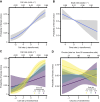Variation in sexual signals and defensive strategies elicits receiver-dependent shifts in attractiveness
- PMID: 40709752
- PMCID: PMC12319409
- DOI: 10.1242/jeb.250360
Variation in sexual signals and defensive strategies elicits receiver-dependent shifts in attractiveness
Abstract
Sexual selection often favors the evolution of conspicuous mating displays. Emitting such overt displays carries the risk of interception by eavesdropping enemies, i.e. predators, parasitoids and parasites that exploit communication systems to find and attack their signaling victims. Yet, many signalers respond to variation in perceived eavesdropper risk, protecting themselves through risk-dependent inducible defenses to mitigate potential costs. Given that signalers are embedded in communication networks in which they interact with other signalers, target receivers and multiple eavesdropping enemies, here we investigated how variation in signaling and defensive strategies impacted by an eavesdropping enemy (frog-biting midges; Diptera: Corethrellidae) affects other receivers in a communication network. Ultimately, we aimed to determine whether and to what extent effects that cascade throughout the network shape relative fitness among chorusing males. Using female choice experiments with túngara frogs (Engystomops pustulosus) and predation experiments with eavesdropping, fringe-lipped bats (Trachops cirrhosus), we show that variation in the call elaboration and defensive strategies of competing males shapes their relative fitness. Defensive strategies targeting eavesdropping frog-biting midges indirectly shift a male's relative attractiveness to females and predatory bats, though the mechanisms and impacts are context and receiver specific. These findings showcase how the frequency-dependent effects of micropredation can dynamically shape variation in secondary sexual characteristics and thus influence the mechanisms driving sexual selection.
Keywords: Engystomops pustulosus; Eavesdropper; Female choice; Foraging; Inducible defense; Predator–prey interactions; Vibratory cues.
© 2025. Published by The Company of Biologists.
Conflict of interest statement
Competing interests The authors declare no competing or financial interests.
Figures


Similar articles
-
Ripple effects in a communication network: anti-eavesdropper defence elicits elaborated sexual signals in rival males.Proc Biol Sci. 2023 Dec 20;290(2013):20231910. doi: 10.1098/rspb.2023.1910. Epub 2023 Dec 20. Proc Biol Sci. 2023. PMID: 38113943 Free PMC article.
-
The ontogeny of decision-making in an eavesdropping predator.Proc Biol Sci. 2025 Apr;292(2045):20250450. doi: 10.1098/rspb.2025.0450. Epub 2025 Apr 30. Proc Biol Sci. 2025. PMID: 40300628
-
Noise pollution and artificial light at night alter selection pressures on sexual signals in an urban adapter.J Evol Biol. 2025 Jul 15:voaf092. doi: 10.1093/jeb/voaf092. Online ahead of print. J Evol Biol. 2025. PMID: 40662860
-
Facultative adjustment of the offspring sex ratio and male attractiveness: a systematic review and meta-analysis.Biol Rev Camb Philos Soc. 2017 Feb;92(1):108-134. doi: 10.1111/brv.12220. Epub 2015 Sep 25. Biol Rev Camb Philos Soc. 2017. PMID: 26405787
-
Survivor, family and professional experiences of psychosocial interventions for sexual abuse and violence: a qualitative evidence synthesis.Cochrane Database Syst Rev. 2022 Oct 4;10(10):CD013648. doi: 10.1002/14651858.CD013648.pub2. Cochrane Database Syst Rev. 2022. PMID: 36194890 Free PMC article.
References
-
- Bateman, P. W. and Fleming, P. A. (2013). Signaling or not-signaling: variation in vulnerability and defense tactics of armored ground crickets (Acanthoplus speiseri: Orthoptera, Tettigoniidae, Hetrodinae). J. Insect Behav. 26, 14-22. 10.1007/s10905-012-9329-5 - DOI
Publication types
MeSH terms
Associated data
Grants and funding
LinkOut - more resources
Full Text Sources
Miscellaneous

